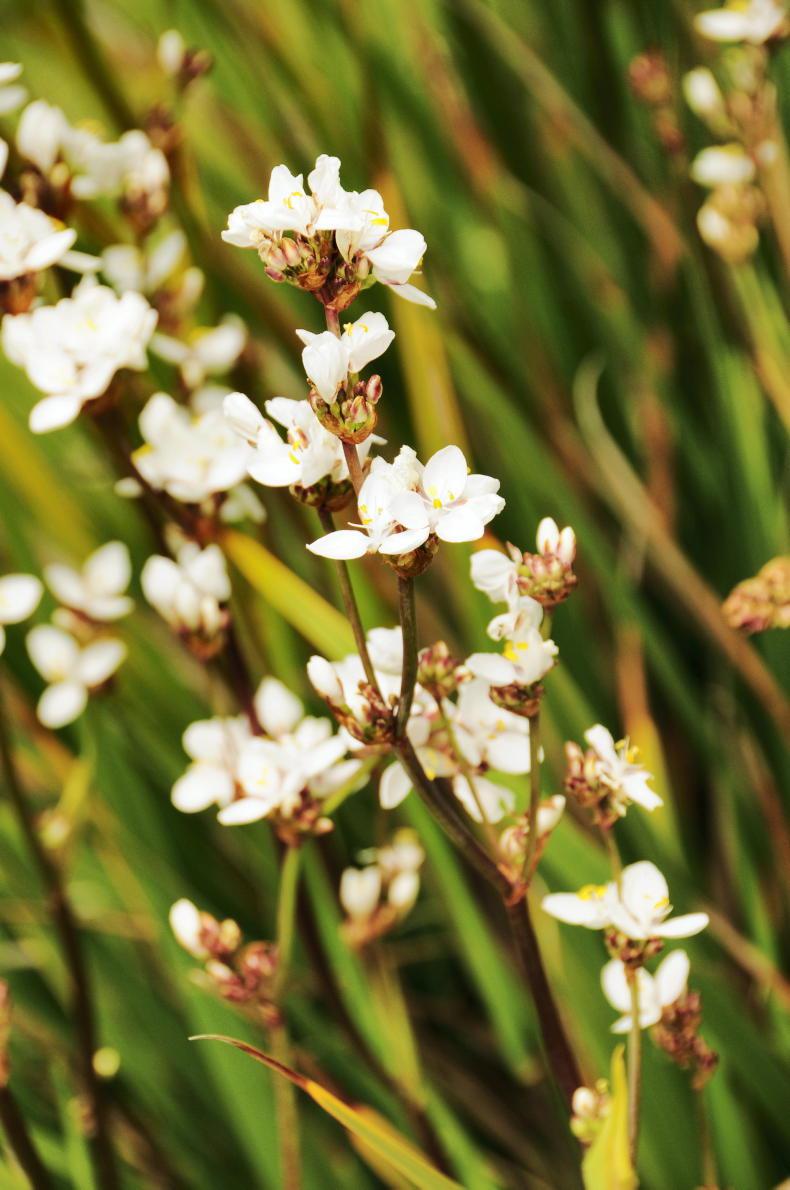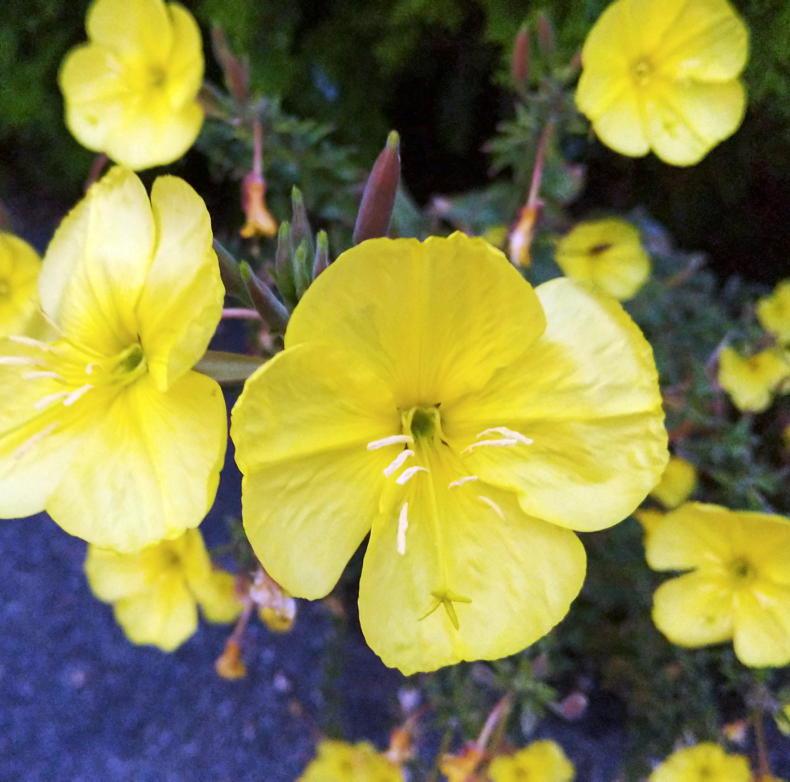Name: Evening primrose, sundrops. Both of these common names refer to the yellow colour of the flowers, which are light yellow or more rich yellow colour in some species. The evening reference is established by the fact that most species the flowers in the evening and at night for pollination by night flying insects.
Botanical name: Oenothera – the word oeno referring to wine and othera meaning to seek out because, apparently, this plant along with others was used in ancient times to flavour wine. It is a member of the willowherb family, the Onagraceae.
Garden use
The evening primrose plant is probably better known for the medicinal properties of its oil than as a garden flower.
The oil is pressed from the seeds of the common evening primrose and is used to mediate menopausal symptoms. There are some very good garden plants among the various species of evening primroses. The common evening primrose, Oenothera biennis, is a biennial flower, which means that it makes a small plant in one year and flowers the next. It was grown as a cottage flower and has escaped in some places because its prolifically produced small seeds are easily carried in mud. It appears occasionally by roadsides and on sand dunes in some parts of the country where it grows amid the marram grass – but always in dry soil in a sunny position.
The cottage garden evening primrose is not popular because it must be sown each year to flower the following year. Alternatively, if it’s left to flower and seed it comes up in unwanted places. Besides, it is rather tall and gangly, even to chest height, which can make it look out of place amid small plants but it would be fine in a cottage-style garden or a country garden.
The perennial evening primrose, Oenothera fruticosa, is more bushy, does not grow as tall and makes a more decorative garden plant topped with stems of deep yellow cup-shaped flowers. ‘Fireworks’ is a pretty selection with dark brown-green leaves and yellow flowers.
Some kinds to try
All the evening primroses are native to North America and the plant came to Europe in the 17th century and was quickly recognised for its medicinal value. One of the nicest kinds is Oenothera missouriensis, which is low-growing, just 15cm high, and spreading. It has large cup-shaped flowers that can be a handbreadth across in bright yellow and flowering for a long period in mid-summer. This is really eye-catching when planted in a small bed near a path or in a raised bed or rockery where it likes the well-drained warm soil.
While most kinds are yellow, there is a beautiful and fragrant white-flowered species called Oenothera speciosa. Although it is from the southern United States, it is hardy. The white-flowered form is rarely seen and the version that is sometimes offered for sale here is a pink-flushed selection called ‘Rosea’. It is smallish spreading plant and sends out underground runners but this is such a lovely plant that this is not a problem. It flowers from early summer right through the warm months and it is very pretty tumbling on to a path or paved area. The evening primroses are bright and splashy and ideal for teaming with blue flowers and brown or grey foliage.
Managing self-sown seedlings

Flowers.
Quite a few garden plants produce viable seed from which new plants or even new types can be raised. The seeds shed in late summer can be sown right away and often germinate quickly or they can be saved for sowing in the springtime. Some kinds readily self-sow and can become a nuisance of weed proportions quite easily. Remove seed heads of flowers that self-sow, such as foxgloves, dierama, fringecups, montbrieta, alchemilla, verbena and libertia if these are not wanted. Not only can these be a nuisance but they tend to come up in the middle of other players and eventually take over. At the same time, seeds of perennial flowers such as lupins, tickseed, mallows and foxgloves could be sown now in seed trays or in celltrays for flowering next year.
Trees, shrubs and roses
Rainfall amounts have been patchy and it is important to check young trees and shrubs for drought. Some plants suffer if they have not made good root growth. Young trees and shrubs, especially bare-root kinds, often take a while to settle. Lack of new shoots is an indicator.
Flowers
Bedding plants in pots and baskets need regular watering and feeding. The roots have filled the pots and watering has become more critical. Feeding every two weeks or so is essential to keep the plants going after the first flush of flowers. Watch for greenflies too, especially on pansies.
Fruit, vegetables and herbs
A late crop of carrots could be sown, also the salad vegetables that mature quickly and Swiss chard for next spring. Do not let weeds go to seed. Plant out winter cabbage varieties, if not already done. Harvest herbs for winter use as they come ready by drying or freezing.
Lawn
Lawns in many parts of the country have been showing signs of drought where soil depth beside herbs or pavements is inadequate. Signs of drought can also be seen under trees where the roots of the trees go deeper than the grass and use the available moisture supply. Do not water.
Greenhouse and house plants
Continue watering and feeding all greenhouse plants to maintain strong growth. Be certain to water plants in pots or grow-bags regularly, these dry out and can be badly set back. Train and side-shoot tomatoes and cucumbers. Take cuttings of deciduous shrubs of all kinds.
Read more
In the garden with Gerry Daly: Lovely lilac!
In the garden with Gerry Daly: fabulous foxgloves
Name: Evening primrose, sundrops. Both of these common names refer to the yellow colour of the flowers, which are light yellow or more rich yellow colour in some species. The evening reference is established by the fact that most species the flowers in the evening and at night for pollination by night flying insects.
Botanical name: Oenothera – the word oeno referring to wine and othera meaning to seek out because, apparently, this plant along with others was used in ancient times to flavour wine. It is a member of the willowherb family, the Onagraceae.
Garden use
The evening primrose plant is probably better known for the medicinal properties of its oil than as a garden flower.
The oil is pressed from the seeds of the common evening primrose and is used to mediate menopausal symptoms. There are some very good garden plants among the various species of evening primroses. The common evening primrose, Oenothera biennis, is a biennial flower, which means that it makes a small plant in one year and flowers the next. It was grown as a cottage flower and has escaped in some places because its prolifically produced small seeds are easily carried in mud. It appears occasionally by roadsides and on sand dunes in some parts of the country where it grows amid the marram grass – but always in dry soil in a sunny position.
The cottage garden evening primrose is not popular because it must be sown each year to flower the following year. Alternatively, if it’s left to flower and seed it comes up in unwanted places. Besides, it is rather tall and gangly, even to chest height, which can make it look out of place amid small plants but it would be fine in a cottage-style garden or a country garden.
The perennial evening primrose, Oenothera fruticosa, is more bushy, does not grow as tall and makes a more decorative garden plant topped with stems of deep yellow cup-shaped flowers. ‘Fireworks’ is a pretty selection with dark brown-green leaves and yellow flowers.
Some kinds to try
All the evening primroses are native to North America and the plant came to Europe in the 17th century and was quickly recognised for its medicinal value. One of the nicest kinds is Oenothera missouriensis, which is low-growing, just 15cm high, and spreading. It has large cup-shaped flowers that can be a handbreadth across in bright yellow and flowering for a long period in mid-summer. This is really eye-catching when planted in a small bed near a path or in a raised bed or rockery where it likes the well-drained warm soil.
While most kinds are yellow, there is a beautiful and fragrant white-flowered species called Oenothera speciosa. Although it is from the southern United States, it is hardy. The white-flowered form is rarely seen and the version that is sometimes offered for sale here is a pink-flushed selection called ‘Rosea’. It is smallish spreading plant and sends out underground runners but this is such a lovely plant that this is not a problem. It flowers from early summer right through the warm months and it is very pretty tumbling on to a path or paved area. The evening primroses are bright and splashy and ideal for teaming with blue flowers and brown or grey foliage.
Managing self-sown seedlings

Flowers.
Quite a few garden plants produce viable seed from which new plants or even new types can be raised. The seeds shed in late summer can be sown right away and often germinate quickly or they can be saved for sowing in the springtime. Some kinds readily self-sow and can become a nuisance of weed proportions quite easily. Remove seed heads of flowers that self-sow, such as foxgloves, dierama, fringecups, montbrieta, alchemilla, verbena and libertia if these are not wanted. Not only can these be a nuisance but they tend to come up in the middle of other players and eventually take over. At the same time, seeds of perennial flowers such as lupins, tickseed, mallows and foxgloves could be sown now in seed trays or in celltrays for flowering next year.
Trees, shrubs and roses
Rainfall amounts have been patchy and it is important to check young trees and shrubs for drought. Some plants suffer if they have not made good root growth. Young trees and shrubs, especially bare-root kinds, often take a while to settle. Lack of new shoots is an indicator.
Flowers
Bedding plants in pots and baskets need regular watering and feeding. The roots have filled the pots and watering has become more critical. Feeding every two weeks or so is essential to keep the plants going after the first flush of flowers. Watch for greenflies too, especially on pansies.
Fruit, vegetables and herbs
A late crop of carrots could be sown, also the salad vegetables that mature quickly and Swiss chard for next spring. Do not let weeds go to seed. Plant out winter cabbage varieties, if not already done. Harvest herbs for winter use as they come ready by drying or freezing.
Lawn
Lawns in many parts of the country have been showing signs of drought where soil depth beside herbs or pavements is inadequate. Signs of drought can also be seen under trees where the roots of the trees go deeper than the grass and use the available moisture supply. Do not water.
Greenhouse and house plants
Continue watering and feeding all greenhouse plants to maintain strong growth. Be certain to water plants in pots or grow-bags regularly, these dry out and can be badly set back. Train and side-shoot tomatoes and cucumbers. Take cuttings of deciduous shrubs of all kinds.
Read more
In the garden with Gerry Daly: Lovely lilac!
In the garden with Gerry Daly: fabulous foxgloves







 This is a subscriber-only article
This is a subscriber-only article










SHARING OPTIONS: